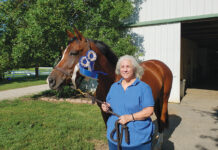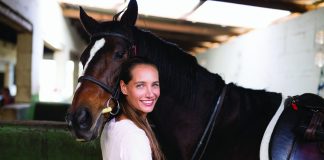
Do you remember the first time you rode a horse? Didn’t it feel wonderful? If you’re like many riders, you decided then and there that one day you would have a horse of your own. A few years may have passed since that first ride, but if you’re at a place in your life where you have the money and the time for a horse, perhaps you can make that dream come true.
We’ve compiled some horse-shopping errors that are easy to make but hard to undo, so take note to make sure you start your search off right and end up with an appropriate horse.
1. Buying a horse without having enough experience.
Before you begin scanning the sale websites, it’s important to ask yourself, “Do I know how to look after a horse?” Have you actually cared for a horse by yourself? Even if you plan to board your horse, you need to know how to take care of him properly. Do you know what vaccinations a horse needs in your area? How often should you deworm him? Would you be able to tell if your horse was sick?
If you don’t know the answers to these basic horse-care questions, it’s time to do some research. Get horse health and care information from reputable horse magazines and websites. If you take lessons, ask to help out at the barn. Find out how the horses are cared for. What do they eat? How much time do they spend in a stall? How does the barn manage their fields so the horses have plenty of grass to eat? How often are the stalls mucked out?
Hold a few horses for the vet when he visits your trainer’s barn, and don’t be afraid to ask any questions you have about equine health. Learn about vaccinations and the diseases that might affect horses in your area.
Once you feel confident in your equine knowledge, you must be honest about your riding ability. If you’ve only been riding a few months, it’s not a great idea to rush out and buy a horse. You should be able to walk, trot and canter confidently, and feel comfortable riding outside the arena. You need to know how to stop a horse safely if he bolts, and calm him down if he spooks.
Take at least six months of riding lessons from an experienced instructor before you begin your horse search. If you’re a nervous rider, explain this to the trainer and request to ride quiet, well-behaved horses. As your confidence grows, ride as many different lesson horses as you can. Sure, it’s nice to ride the same lesson horse every time, but you’ll become a better equestrian if you can ride different types of horses.
If you’re lucky enough to have a friend who has safe horses to ride, ask if you can horse-sit, muck out a few stalls, or clean tack in exchange for saddle time.
As you become a more experienced rider, you’ll be capable of riding a variety of mounts. This will open up your search when you finally feel ready to buy a horse.
2. “I want a palomino stallion!”
No, you don’t. You want a horse that is safe, well-mannered and a pleasure to ride. A good horse can be any color, age, breed, size or shape. Keep an open mind, and don’t limit yourself to a particular breed or age. In fact, older horses usually make better first horses.
You can be a little pickier if you want to do a specific activity with your horse. If you love trail riding, a gaited horse might be just what you’re looking for—and there are plenty of gaited breeds to choose from. If you want to jump, consider a Thoroughbred or Thoroughbred-cross. If you plan to show in western pleasure classes, then maybe an Appaloosa, Quarter Horse or Paint Horse might be for you. Have a chat with your trainer about what kind of horse she thinks would match your riding interests.
Looking for a horse is time-consuming, so rule out horses that are obviously inappropriate for a new or returning rider, like stallions or green-broke babies.
If you’ve been riding regularly, you probably have a good idea about what size horse you need. Look for one that’s big enough to carry you with ease, but not so huge that you can’t ride and handle him confidently.
3. Keeping Your Search Online Only
Experienced riders and trainers may be able to find diamonds in the rough on Craigslist, but you probably won’t. Avoid the free and bargain horses, and look for a horse in more sensible ways.
If you ride regularly with a trainer, she should be your first stop on your horse search. One of the wonderful lesson horses you ride may be for sale. Your trainer may also have other horses in her barn that might suit you, and she probably knows people who buy and sell horses. Your trainer knows how well you ride, and she should do her best to match you up with an appropriate horse. It’s in her best interest to keep you happy in the saddle; your lesson payments and boarding fees keep her in business.
If your trainer knows of a horse for sale, it may be possible to try the horse several times or take him on trial for a week or two. This gives you some time to figure out if he’s a good match for you.
Word of mouth is another way to find a good horse. Let your horsey friends know that you’re looking for one. Post your horsey requirements on your Facebook page. Often, the best horses aren’t advertised because they’re snapped up by people in the know. Keep your ears open around the barn. It can be a good idea to buy a locally known horse because it will be easy to find out about his temperament, health and past performance.
Online ads are a way to look at lots of horses in your area. On many horse-sale websites, you can type in the kind of horse you want, what activities you want to do, your zip code and how much you want to pay. Click “Enter” and, if you’re lucky, a selection of horses will magically appear. Sale websites give you the chance to learn more about a horse by looking at pictures and videos of him.
Remember that a horse can sound wonderful in an ad, but it can be a different story when you meet him. Look for descriptions like “ideal first horse,” “packer,” “honest” or “perfect for a novice rider.” Avoid horses that are described as “green,” “needs
a confident rider,” “spirited” or “not a novice ride.”
4. “Rescuing” a horse.
Adopting a horse directly from an equine charity may seem like a worthwhile endeavor, but it’s not really a great idea for a first-time owner. Many of the adoptable horses may have been neglected or abused, and they may be nervous or have health problems.
Charities take in a lot of untrained horses, and unless the rescue has an experienced onsite trainer who works with the horses on a regular basis, it’s unlikely you’re going to find an experienced riding horse to adopt. Yes, it happens once in a while, but you may be better off helping a charity by volunteering your time or donating money rather than by adopting a horse.
There are several charities that excel in taking off-the-track Thoroughbreds and Standardbreds and retraining them to be riding horses. If you’re a pretty good rider, this may be an option for you—after the horse has been in training for several months and has been assessed as being suitable for the riding activities you want to do.
Another place to avoid when searching for a first horse is an auction. You’ll know very little about the horses for sale. Unless you just happen to be an equine veterinarian, it’s difficult to figure out a horse’s age or judge how healthy he is by looking at him for five minutes in a sale pen.
It’s also unlikely you’ll be able to ride the horse or see him move properly before he goes on the auction block. And it’s a sad fact of life that many of the horses that end up at low-end auctions may be lame, ill or have a behavioral problem that the sellers don’t really want anyone to know about.
At more dubious auctions, you may see neglected or injured animals that will break your heart, and you might end up bidding to beat out a kill buyer.
5. Taking on a project.
Once you’ve found a few horses that seem like suitable candidates, arrange to visit them. Take an experienced horseperson or your trainer with you to meet the horse, because it’s important to get a second opinion. Ask your companion to video you while you ride your potential mount so you can study the footage later.
Arrive on time for your appointment. The horse should be ready for you to view him. If he looks sweaty or tired, it’s likely he’s been longed or ridden already; this is cause for suspicion. Why did the seller need to tire out the horse? Is the horse hyper or badly behaved?
He should look healthy, with a shiny coat and good weight. Look at his feet. Have they been recently shod or trimmed? A reputable seller is not going to show you a dirty, skinny horse with overgrown hooves.
You want a horse that’s easy to handle. Watch the seller groom him and pick out his feet. Observe closely as he’s tacked up. Is he calm and quiet, or does he pin back his ears and swish his tail? If he acts skittish or grumpy, he’s probably not the horse for you. Don’t assume that you will be able to work with a horse to improve his behavior. You may not be experienced enough to deal with a problem horse. Even if you have a trainer who can help or know a natural horsemanship expert you can send the horse to, why bother? An appropriate first horse really shouldn’t need 30 days with a trainer before you hop on him. There are plenty of well-behaved horses out there, so be patient until you find one that you can handle safely by yourself.
Note the tack the horse wears because it will give you some clues about his rideability. A good first horse should go nicely in a simple snaffle or a fairly mild western curb bit. Huge shanks or a severe twisted mouthpiece are warning signs. And there shouldn’t be any need for other gadgets, such as tie-downs or draw reins, during your test ride.
Ask the seller to ride the horse before you get on. The horse should walk, trot and canter calmly. If you want to jump, ask to see the horse pop over a few fences at the height you’d like to jump. If you want to trail ride, ask the seller to take the horse out to an open field and watch him trot and canter a bit. If the horse bucks, jigs or acts ridiculous and you feel apprehensive about riding him, say thank you and goodbye.
If you’re able to ride the horse successfully and both you and your trainer like him, then you can think about buying him.

6. Skipping the pre-purchase exam.
If you can afford to buy and care for a horse, you should be able to scrape together enough money for a pre-purchase exam. It’s so important to have a potential horse examined by a veterinarian before you hand over any money. She may discover a health problem that could cost you lots of money to treat. A mild lameness might be the result of an old tendon injury that hasn’t quite healed. A slightly runny nose might mean the horse has an allergy that could prevent him from breathing properly and affect his work. You don’t want to bring a horse home only to find that you can’t ride him anytime soon—not a great scenario for a one-horse owner who has nothing else to ride and who must pay a board bill every month.
During a pre-purchase exam, the vet will assess your prospect’s teeth to determine his approximate age. She’ll look at his ears, nose and throat and listen to his lungs. She’ll check his heart to make sure he doesn’t have a murmur, and she’ll examine his eyes for cataracts that could cause blindness.
The vet will run her hands all over the horse’s body and legs, searching for swellings, lumps and bumps that could indicate the potential for soundness problems in the future. She’ll use hoof testers to make sure the horse’s feet aren’t sore. She may watch the horse walk, trot and canter on a longeline to see if he is lame. She will probably also perform a flexion test by lifting up his legs to bend his joints for about 30 seconds, and then watch him trot away from her quickly. If the horse looks gimpy while trotting away, he may have joint problems that could cause issues down the road.
Leg X-rays raise the price of a pre-purchase exam, but it’s worth having them if you plan to compete your horse in athletic activities like reining, dressage or jumping. Most vets have access to a portable X-ray machine, so you can look at the results almost instantly. Leg X-rays can show you if the horse has any joint abnormalities or arthritis that might cause lameness.
After the exam, the vet will give you her opinion about the suitability of the horse for the activities you want to do with him. If you plan to lightly trail ride your horse, a few lumps and bumps here and there probably won’t affect his performance. But if you aspire to do eventing or barrel racing, you need to buy a horse that has strong, clean legs. Decide if you can live with the horse’s imperfections. If you can, hand over the money. If you can’t, your horse search continues.
It might take you awhile to find a suitable mount. Be patient. Don’t buy a horse that’s not quite what you’re looking for just because you’re chomping at the bit to hit the trails or start showing. If you stay true to your needs and avoid making these common horse-shopping mistakes, the right horse will come along eventually.
This article originally appeared in the 2015 issue of Your New Horse.






Very practical information.